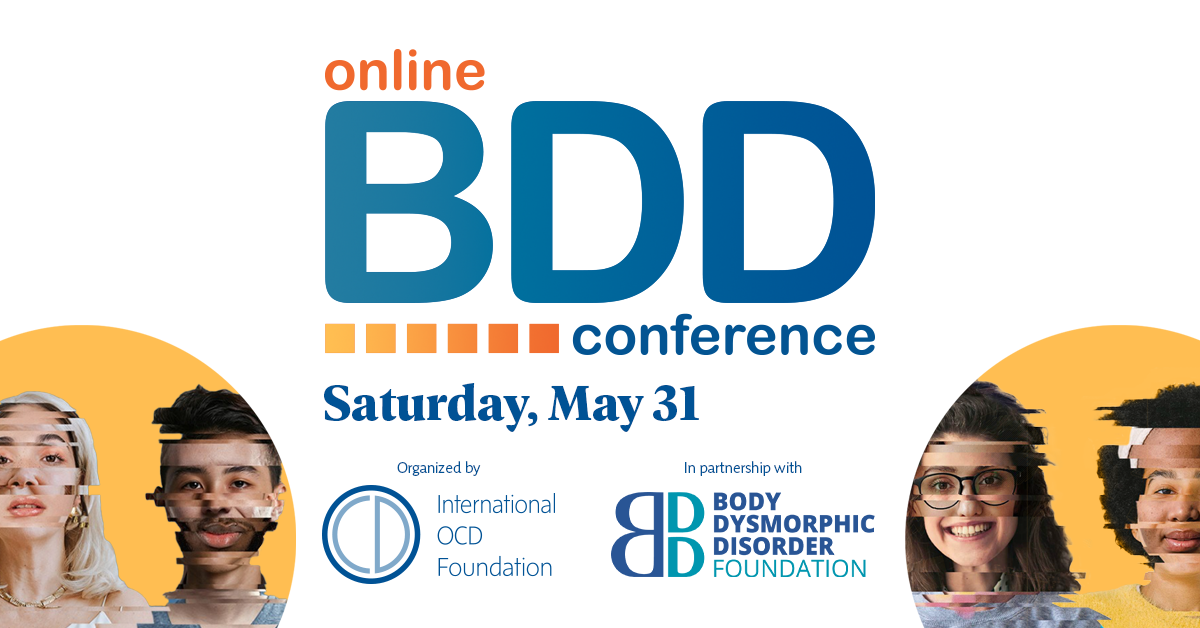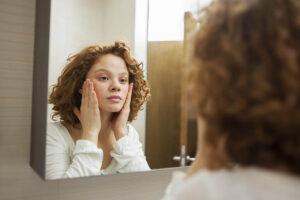What does it mean to have Body Dysmorphic Disorder (BDD)?
Do you look in the mirror and become fixated on a pimple or a scar or other flaw that you perceive on your skin? Or do you worry that your nose looks weird - or that some other part of your body looks flawed or defective?
When these thoughts and feelings become time-consuming and cause significant emotional distress (such as anxiety, sadness, or self-consciousness) and/or significant problems in your daily life — this is body dysmorphic disorder. In addition, at some point, people with BDD also engage in excessive repetitive compulsive behaviors (such as comparing with others or excessively checking mirrors or grooming) in response to the appearance concerns.
Register now for the Online BDD Conference!

You are not alone. Whether you're newly diagnosed or have been living with Body Dysmorphic Disorder (BDD) for years, the IOCDF BDD Conference is a space for understanding, connection, and support. Join leading experts, individuals with BDD, and their loved ones for a day of hope and healing.
Register now to be part of a community that truly gets it.
What are the common signs and symptoms of BDD?
- Frequent thoughts about perceived flaws in appearance (at least an hour a day if you add up all the time you spend).
- Spending a lot of time staring in a mirror and/or other reflective surfaces while fixated on the perceived flaw - or in some cases, avoidance of mirrors/reflective surfaces.
- Covering up the disliked body area (for example, using hats, scarves, make-up, body position, or posture).
- Repeatedly asking others if you look okay (also referred to as ‘reassurance seeking’).
- Frequent appointments with medical professionals/cosmetic surgeons to get the disliked body area “fixed.”
- Repeated plastic surgery or dermatologic treatment.
- Compulsive skin picking - which includes using fingernails, tweezers, and other sharp implements - to try to remove perceived blemishes or "fix" other perceived skin flaws.
- Avoiding social situations, public places, work, school, and other situations where people might see your perceived appearance flaws.
- Leaving the house less often or only going out at night to prevent others from seeing the “flaw.”
- Keeping your obsessions and compulsions secret due to feelings of shame
- Feelings of disgust, depression, anxiety, low self-esteem, suicidal thinking, etc., because the perceived appearance flaws are so upsetting.
It is important to note that people with BDD look "normal" to other people. In other words, the perceived appearance flaws are, in reality, minimal or nonexistent. However, the person with BDD usually doesn’t realize this. They think that their flaws are readily visible to others and look as ugly to other people as they do to themselves. This is probably because people with BDD have differences in visual processing – they seem to actually see themselves differently than other people do (click here to learn more about visual processing in BDD).
How do you tell the difference between being unhappy with a part of your appearance and BDD?
Most people are unhappy with some aspect of how they look, but most people don't have BDD. How do you tell the difference between normal appearance concerns and BDD? If you spend at least an hour a day thinking about your perceived appearance flaws, and this preoccupation interferes with day-to-day functioning or causes significant emotional distress, then the person is diagnosed with BDD.
Thus, you may have BDD if:
- You spend at least one hour in total a day (add up all the time you spend) thinking about the perceived appearance flaws, AND
- Preoccupation with the perceived flaws interferes with day-to-day functioning. Examples are difficulty concentrating; problems with work, school, or other responsibilities (for example, being late, missing work or school, or being less productive); social avoidance; not dating; and cancelling or missing activities with friends or family, OR
- Preoccupation with the perceived appearance flaws causes significant emotional distress. Examples are depression, anxiety, sadness, frustration, anger, embarrassment, shame, and feeling that life isn't worth living.
- In addition, at some point you have performed repetitive behaviors in response to the appearance concerns. Examples are repetitive mirror checking, grooming, asking others how you look or if you look okay, skin picking, and comparing your appearance with that of other people.
NOTE: If you are preoccupied ONLY with thinking that you're "too fat," or that parts of your body (such as your stomach or thighs) are "too fat," it is important to determine whether or not an eating disorder is a more fitting diagnosis than BDD.
What parts of the body are often the focus of BDD?
- Most often, the head or face (for example, hair, nose, skin, eyes, chin, jaw, neck, face size or shape) are the focus of concern. However, people with BDD can be excessively worried about any body part.
- Other common areas of concern include the arms, legs, stomach, hips, weight, and body build (for example, feeling not muscular enough).
- On average, people with BDD are concerned with a total of 5-7 different body parts in the past or currently. However, some people worry about just one body area, and others intensely dislike virtually everything about how they look.
Confusing Terms for BDD
Increasingly, an array of confusing terms are being used to refer to BDD. Actually, it's hard to know whether these terms are referring to BDD or to normal appearance concerns, because none of them have been clearly defined or have an agreed-upon definition. None of these terms are included in or defined in DSM-5 or ICD 11, the two official manuals that are used around the world to define and classify mental disorders.
 These confusing terms include body dysmorphia, zoom dysmorphia, acne dysmorphia, skin dysmorphia, penile dysmorphia, and other similar terms. The problem is that we don't know whether people who use these terms are referring to the disorder BDD - which has the specific definition provided above - or to normal and common non-BDD appearance concerns.
These confusing terms include body dysmorphia, zoom dysmorphia, acne dysmorphia, skin dysmorphia, penile dysmorphia, and other similar terms. The problem is that we don't know whether people who use these terms are referring to the disorder BDD - which has the specific definition provided above - or to normal and common non-BDD appearance concerns.
One reason it's important to differentiate BDD from more normal body image concerns is that BDD is often very serious and can even lead to suicide. It also needs to be treated, and we have excellent treatments for BDD. In contrast, non-BDD appearance concerns do not require treatment. So this is why it’s important to refer to BDD as "body dysmorphic disorder," rather than one of these other terms.
Katharine Phillips, MD, is internationally known for her pioneering research and clinical work in body dysmorphic disorder and related conditions. She has published more than 350 scientific papers, and she has authored or edited nine books on BDD and obsessive-compulsive and related disorders, including a 2017 edited volume on BDD (published by Oxford University Press). She provides evaluation and treatment for patients in her clinical practice in New York City, where she is Professor of Psychiatry at Weill Cornell Medical College. Dr. Phillips is also a member of the IOCDF’s Scientific and Clinical Advisory Board. To learn more visit www.KatharinePhillipsMD.com.
